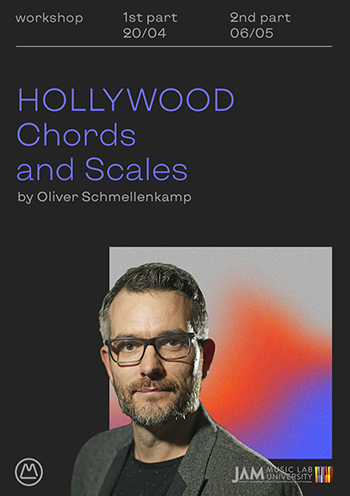
- дней
- часов
- минут
Workshop: HOLLYWOOD — CHORDS AND SCALES
Давно хотели разобраться и ответить на вопрос: как пишется современная музыка для кино и чем этот подход отличается от работы с поп-музыкой? Тогда на нашем двухдневном мастер-классе, мы вместе попробуем найти ответы на большинство вопросов.
Лектор мастер-класса: Oliver Schmellenkamp
Оливер - один из ведущих композиторов Австрии и преподаватель Венского университета Jam Music Lab. Он имеет большой опыт сотрудничества с международными компаниями, брендами, медиа и игровыми компаниями, включая американские телеканалы Fox, National Geographic, German ZDF, сотни саундтреков для Xbox и Nintendo, а также бренды Pepsi, CocaCola, Ford, Boss, McDonald's, AirBerlin и многие другие.
Детали:
2 занятия по 4 часа
Даты: 20 апреля | 6 мая
Время: 11:00 - утро
Формат: он-лайн
Обзятально: выполнение домашнего задания
Язык мастер-класса: английский
Количество мест: 15
На этом мастер-классе:
1. Прокачать знания в музыкальной теории, эмоциональной и хроматической гармонии и то, как применить это на практике.
2. На время вернемся в прошлое, к музыке композиторов Штрауса, Вагнера и Стравинского, чтобы посмотреть, какие приемы можно позаимствовать у них и использовать в наше время. Изучим подход современных композиторов: Ханса Циммера, Макса Рихтера и Стива Яблонского и их работу с музыкальным материалом.
3. На примерах известных всем фильмов, среди которых: Звездные Войны, Я робот, Охотники за привидениями, Прибытие и многих других, мы узнаем, как с помощью современного подхода к написанию музыки, используя знания, полученные на курсе составлять музыкальные ландшафты, которые помогу дополнить и раскрыть события происходят на экране.
Пока кто-то мечтает выиграть "Оскар" и пишет сценарий фильма - подтяни свои знания и напиши будущий хит в мире саундтреков. До встречи на мастер-классе!
Программа занятий:
Warm-Up
I wouldn't say I like it when music theory turns into rocket science; I will keep it simple as far as possible. In the warm-up, we will talk about some basics that are important for this course.
Everything else I will explain (step by step) in the following chapters.
- Triads
- Scales
- Composers Piano
1. Emotional Harmony
This chapter takes an emotional look at the diatonic triads on the major and minor scales.
In examples from Hans Zimmer, Max Richter, Steve Jablonsky and Alan Silvestri, we cover how Diatonic Triads can be used to reach the listener's heart.
Composing with Major Scale
- Diatonic Triads
- Emotional Concept
- Harmonizing a Melody
Case Studies
- Gladiator
- Express
Composing with Minor Scale
- Diatonic Triads
- Emotional Concept
- Harmonizing a Melody
Case Studies
- Arrival
- Dark Knight
- Transformers
Orchestration/Scoring Tipp
To Picture
2. Magic Modes
The modes are an important part of a composer's toolbox, and each mode represents its own world with its specific associations and narratives.
We have already discussed major and minor scales; now, let's look at the other modes.
We see examples from films like Da Vinci Code, Simpsons, Back to the Future, Indiana Jones and Star Wars.
The Lydian Mode - About fairytales and mermaids
- The Lydian scale and chords
- Composing with the mode
Case Studies
- Back to the Future
- Simpsons
- Universal Logo
- ET - Little Mermaid
The Dorian Mode - About pirates and the middle ages
- The Dorian scale and chords
- Composing with the mode
Case Studies
- American Beauty
- Star Wars
- Pirates of The Caribbean
The Phrygian Mode - About the desert and mummies
- The Phrygian scale and chords
- The Phrygian dominant scale
- Composing with the mode
- Double Harmonic
Case Studies
- The Mummy
- Lawrence of Arabia
- Stargate
The Mixolydian Mode - About crowdy city and mystical
- The Mixolydian scale and chords
- Mixolydian b13
- Composing with the mode
Case Studies
- Hotel For Dogs
- Ghostbusters?
- The Locrian Mode – Dark and Heavy
The Locrian scale and chords
- Mix the Modes
- it is possible to mix the modes or to move from one mode to another.
3. Chromatic
The chromatic harmony stands for the supernatural, the wonderful, the mysterious, the mystical and the fairytale,
and goes back to the composer of the 19th and 20th centuries like Mahler, Holst, Wagner, Strauss and Stravinsky.
We can put a major or minor chord on every step of the chromatic scale with this concept.
Chromatic Mediants
- Composing with Chromatic Mediants
- The Common Tone
Case Studies
- Atlantis
- iRobot
- Lord of The Rings
- Star Wars
- Orchestration/Scoring Tipp
- To Picture
- Tritone Relationship
- Composing with Tritone Related Chords
- Motifs and Melodies
Case Studies
- Indiana Jones
- iRobot
- Star Wars
- Orchestration/Scoring Tipp
- To Picture
Two Chord Relationships - The Shortcuts for Film Composer
- Chords and Narratives
I-I I-II I-III I-IV I-V I-VI I-VII
- String Theory
Case Studies
- Universal Logo
- iRobot
- Atlantis
4. Harmonic Direction
In film music, there are several possibilities to move from one chord to another. Each of these possibilities has its own sound.
- Progression
- Parallel
- Connection and Transformation
- String Theory
Orchestration/Scoring Tipp
- Developing melodies
- Motivic development
5. Chords and Colors
In this episode, we see which chords (besides triads) composers like John Williams, Danny Elfman and Bernard Hermann use,
to express different emotions.
- Hitchcock Chord
- The b13 Sound
- Cluster
- Poly Chords
- The Star Wars Chord
- John Williams Brass Triads
- Add Notes
- Compound Chords
- Diminished Transformation
- Pedals
6. Fancy Scales
Not only the modes are used by film composers, but other scales are used in certain situations. Here is a small overview.
- Synthetic Scales
- Octatonic
- Whole Tone
Case Studies
- Back to the Future
- Ghostbusters
